Co-Doped Magnesium Oxychloride Composites with Unique Flexural Strength for Construction Use
Abstract
:1. Introduction
2. Materials and Methods
3. Results and Discussion
4. Conclusions
- (i).
- the micro- and macro-structural parameters analyses showed the base of the enhancement caused by the carbon-based nanoadditives that significantly decreased the porosity, which was reduced by ~15.8% for MOC-GO-OMWCNT-0.1 and ~28.9% for MOC-GO-OMWCNT-0.2;
- (ii).
- the great drop of porosity led to the increase in the mechanical parameters, where the flexural strength values increased by 55.3% and 92.1% for the samples containing 0.1 and 0.2 wt. % of each nanoadditive, respectively;
- (iii).
- as the volume of pores decreased due to their filling and interlocking with the nanoadditives, the water transport and storage properties were significantly lowered; thus, the improved water resistance of the MOC matrix can be anticipated—this effect of the nanodopants is crucial for the MOC-based composites, which are usually considered as materials with very poor water resistance;
- (iv).
- the materials thermal conductivity was quite high due to the decreased porosity, but also as a result of adapting the thermal conductivities of the used GO and OMWCNTs, which are generally very high.
Author Contributions
Funding
Institutional Review Board Statement
Informed Consent Statement
Data Availability Statement
Acknowledgments
Conflicts of Interest
References
- Sorel, S. On a new magnesium cement. CR Acad. Sci. 1867, 65, 102–104. [Google Scholar]
- Li, K.; Wang, Y.; Yao, N.; Zhang, A. Recent progress of magnesium oxychloride cement: Manufacture, curing, structure and performance. Constr. Build. Mater. 2020, 255, 119381. [Google Scholar] [CrossRef]
- Kastiukas, G.; Ruan, S.; Unluer, C.; Liang, S.; Zhou, X. Environmental Assessment of Magnesium Oxychloride Cement Samples: A Case Study in Europe. Sustainability 2019, 11, 6957. [Google Scholar] [CrossRef] [Green Version]
- Beaudoin, J.J.; Ramachandran, V.S. Strength development in magnesium oxychloride and other cements. Cem. Concr. Res. 1975, 5, 617–630. [Google Scholar] [CrossRef] [Green Version]
- Góchez, R.; Wambaugh, J.; Rochner, B.; Kitchens, C. Kinetic study of the magnesium oxychloride cement cure reaction. J. Mater. Sci. 2017, 52, 7637–7646. [Google Scholar] [CrossRef]
- Montle, J.; Mayhan, K. The role of magnesium oxychloride as a fire-resistive material. Fire Technol. 1974, 10, 201–210. [Google Scholar] [CrossRef]
- Jirickova, A.; Lojka, M.; Lauermannova, A.M.; Antonacik, F.; Sedmidubsky, D.; Pavlikova, M.; Zaleska, M.; Pavlik, Z.; Jankovsky, O. Synthesis, Structure, and Thermal Stability of Magnesium Oxychloride 5Mg(OH)(2).MgCl2.8H(2)O. Appl. Sci. 2020, 10, 1683. [Google Scholar] [CrossRef] [Green Version]
- Lauermannová, A.-M.; Lojka, M.; Jankovský, O.; Faltysová, I.; Pavlíková, M.; Pivák, A.; Záleská, M.; Pavlík, Z. High-performance magnesium oxychloride composites with silica sand and diatomite. J. Mater. Res. Technol. 2021, 11, 957–969. [Google Scholar] [CrossRef]
- Chau, C.K.; Chan, J.; Li, Z. Influences of fly ash on magnesium oxychloride mortar. Cem. Concr. Compos. 2009, 31, 250–254. [Google Scholar] [CrossRef]
- Li, Y.; Yu, H.; Zheng, L.; Wen, J.; Wu, C.; Tan, Y. Compressive strength of fly ash magnesium oxychloride cement containing granite wastes. Constr. Build. Mater. 2013, 38, 1–7. [Google Scholar] [CrossRef]
- He, P.; Poon, C.S.; Tsang, D.C.W. Comparison of glass powder and pulverized fuel ash for improving the water resistance of magnesium oxychloride cement. Cem. Concr. Compos. 2018, 86, 98–109. [Google Scholar] [CrossRef]
- Zhou, X.; Li, Z. Light-weight wood–magnesium oxychloride cement composite building products made by extrusion. Constr. Build. Mater. 2012, 27, 382–389. [Google Scholar] [CrossRef] [Green Version]
- He, P.; Hossain, M.U.; Poon, C.S.; Tsang, D.C.W. Mechanical, durability and environmental aspects of magnesium oxychloride cement boards incorporating waste wood. J. Clean. Prod. 2019, 207, 391–399. [Google Scholar] [CrossRef]
- Lauermannová, A.-M.; Faltysová, I.; Lojka, M.; Antončík, F.; Sedmidubský, D.; Pavlík, Z.; Pavlíková, M.; Záleská, M.; Pivák, A.; Jankovský, O. Regolith-based magnesium oxychloride composites doped by graphene: Novel high-performance building materials for lunar constructions. FlatChem 2021, 26, 100234. [Google Scholar] [CrossRef]
- Fediuk, R.; Lesovik, V.; Mochalov, A.; Otsokov, K.; Lashina, I.; Timokhin, R. Composite binders for concrete of protective structures. Mag. Civil Eng. 2018, 6, 208–218. [Google Scholar]
- Li, Z.; Chau, C. Influence of molar ratios on properties of magnesium oxychloride cement. Cem. Concr. Res. 2007, 37, 866–870. [Google Scholar] [CrossRef]
- Ba, H.; Guan, H. Influence of MgO/MgCl2 molar ratio on phase stability of magnesium oxychloride cement. J. Wuhan Univ. Technol. Mater. Sci. Ed. 2009, 24, 476–481. [Google Scholar] [CrossRef]
- Liu, Z.; Wang, S.; Huang, J.; Wei, Z.; Guan, B.; Fang, J. Experimental investigation on the properties and microstructure of magnesium oxychloride cement prepared with caustic magnesite and dolomite. Constr. Build. Mater. 2015, 85, 247–255. [Google Scholar] [CrossRef]
- Chau, C.K.; Li, Z. Microstructures of magnesium oxychloride Sorel cement. Adv. Cem. Res. 2008, 20, 85–92. [Google Scholar] [CrossRef]
- Walling, S.A.; Provis, J.L. Magnesia-Based Cements: A Journey of 150 Years, and Cements for the Future? Chem. Rev. 2016, 116, 4170–4204. [Google Scholar] [CrossRef]
- Jankovský, O.; Lojka, M.; Lauermannová, A.-M.; Antončík, F.; Pavlíková, M.; Pavlík, Z.; Sedmidubský, D. Carbon Dioxide Uptake by MOC-Based Materials. Appl. Sci. 2020, 10, 2254. [Google Scholar] [CrossRef] [Green Version]
- Zhang, F.-J.; Sun, X.-Y.; Li, X.; Zhang, D.; Xie, W.-J.; Liu, J.; Oh, W.-C. Study on Water Resistance of Environmentally Friendly Magnesium Oxychloride Cement for Waste Wood Solidification. J. Korean Ceram. Soc. 2018, 55, 446–451. [Google Scholar] [CrossRef] [Green Version]
- Zhang, X.; Ge, S.; Wang, H.; Chen, R. Effect of 5-phase seed crystal on the mechanical properties and microstructure of magnesium oxychloride cement. Constr. Build. Mater. 2017, 150, 409–417. [Google Scholar] [CrossRef]
- Sorre, C.A.; Armstron, C.R. Reactions and Equilibria in Magnesium Oxychloride Cements. J. Am. Ceram. Soc. 1976, 59, 51–54. [Google Scholar] [CrossRef]
- Robinson, W.; Waggaman, W. Basic magnesium chlorides. J. Phys. Chem. 2002, 13, 673–678. [Google Scholar] [CrossRef] [Green Version]
- Matkovic, B.; Young, J. Microstructure of magnesium oxychloride cements. Nat. Phys. Sci. 1973, 246, 79. [Google Scholar] [CrossRef]
- Gong, W.; Yu, H.; Ma, H.; Qiao, H.; Chen, G. Study on corrosion and anticorrosion of rebar in magnesium oxychloride cement concrete. Emerg. Mater. Res. 2019, 8, 94–104. [Google Scholar] [CrossRef]
- Amran, M.; Fediuk, R.; Vatin, N.; Huei Lee, Y.; Murali, G.; Ozbakkaloglu, T.; Klyuev, S.; Alabduljabber, H. Fibre-Reinforced Foamed Concretes: A Review. Materials 2020, 13, 4323. [Google Scholar] [CrossRef]
- Li, Y.; Li, Z.; Pei, H.; Yu, H. The influence of FeSO4 and KH2PO4 on the performance of magnesium oxychloride cement. Constr. Build. Mater. 2016, 102, 233–238. [Google Scholar] [CrossRef]
- Guan, B.; Tian, H.; Ding, D.; Wu, J.; Xiong, R.; Xu, A.; Chen, H. Effect of Citric Acid on the Time-Dependent Rheological Properties of Magnesium Oxychloride Cement. J. Mater. Civ. Eng. 2018, 30, 04018275. [Google Scholar] [CrossRef]
- Chen, X.; Zhang, T.; Bi, W.; Cheeseman, C.R. Effect of tartaric acid and phosphoric acid on the water resistance of magnesium oxychloride (MOC) cement. Constr. Build. Mater. 2019, 213, 528–536. [Google Scholar] [CrossRef]
- Wu, C.; Chen, W.; Zhang, H.; Yu, H.; Zhang, W.; Jiang, N.; Liu, L. The hydration mechanism and performance of Modified magnesium oxysulfate cement by tartaric acid. Constr. Build. Mater. 2017, 144, 516–524. [Google Scholar] [CrossRef]
- Wu, C.; Zhang, H.; Yu, H. The effects of alumina-leached coal fly ash residue on magnesium oxychloride cement. Adv. Cem. Res. 2013, 25, 254–261. [Google Scholar] [CrossRef]
- He, P.; Poon, C.S.; Tsang, D.C.W. Using incinerated sewage sludge ash to improve the water resistance of magnesium oxychloride cement (MOC). Constr. Build. Mater. 2017, 147, 519–524. [Google Scholar] [CrossRef]
- Lee, C.; Wei, X.; Kysar, J.W.; Hone, J. Measurement of the Elastic Properties and Intrinsic Strength of Monolayer Graphene. Science 2008, 321, 385–388. [Google Scholar] [CrossRef]
- Novoselov, K.S.; Geim, A. The rise of graphene. J. Nat. Mater. 2007, 6, 183–191. [Google Scholar]
- Falkovsky, L.A. Optical properties of graphene. J. Phys. Conf. Ser. 2008, 129, 012004. [Google Scholar] [CrossRef]
- Jankovský, O.; Lojka, M.; Luxa, J.; Sedmidubský, D.; Pumera, M.; Sofer, Z. Introduction of sulfur to graphene oxide by Friedel-Crafts reaction. FlatChem 2017, 6, 28–36. [Google Scholar] [CrossRef]
- Panchakarla, L.; Subrahmanyam, K.; Saha, S.; Govindaraj, A.; Krishnamurthy, H.; Waghmare, U.; Rao, C. Synthesis, structure, and properties of boron-and nitrogen-doped graphene. Adv. Mater. 2009, 21, 4726–4730. [Google Scholar] [CrossRef]
- Qu, L.; Liu, Y.; Baek, J.-B.; Dai, L. Nitrogen-doped graphene as efficient metal-free electrocatalyst for oxygen reduction in fuel cells. ACS Nano 2010, 4, 1321–1326. [Google Scholar] [CrossRef]
- Wu, J.; Xie, L.; Li, Y.; Wang, H.; Ouyang, Y.; Guo, J.; Dai, H. Controlled chlorine plasma reaction for noninvasive graphene doping. J. Am. Chem. Soc. 2011, 133, 19668–19671. [Google Scholar] [CrossRef]
- Yang, Z.; Yao, Z.; Li, G.; Fang, G.; Nie, H.; Liu, Z.; Zhou, X.; Chen, X.A.; Huang, S. Sulfur-doped graphene as an efficient metal-free cathode catalyst for oxygen reduction. ACS Nano 2011, 6, 205–211. [Google Scholar] [CrossRef]
- Zhang, C.; Mahmood, N.; Yin, H.; Liu, F.; Hou, Y. Synthesis of Phosphorus-Doped Graphene and its Multifunctional Applications for Oxygen Reduction Reaction and Lithium Ion Batteries. Adv. Mater. 2013, 25, 4932–4937. [Google Scholar] [CrossRef] [PubMed]
- Fu, Q.; Gao, B.; Dou, H.; Hao, L.; Lu, X.; Sun, K.; Jiang, J.; Zhang, X. Novel non-covalent sulfonated multiwalled carbon nanotubes from p-toluenesulfonic acid/glucose doped polypyrrole for electrochemical capacitors. Synth. Met. 2011, 161, 373–378. [Google Scholar] [CrossRef]
- Ferreira, F.V.; Francisco, W.; Menezes, B.R.C.D.; Cividanes, L.D.S.; Coutinho, A.D.R.; Thim, G.P. Carbon nanotube functionalized with dodecylamine for the effective dispersion in solvents. Appl. Surf. Sci. 2015, 357, 2154–2159. [Google Scholar] [CrossRef]
- Cividanes, L.D.S.; Simonetti, E.A.N.; de Oliveira, J.I.S.; Serra, A.A.; Carlos de Souza Barboza, J.; Thim, G.P. The sonication effect on CNT-epoxy composites finally clarified. Polym. Compos. 2017, 38, 1964–1973. [Google Scholar] [CrossRef]
- Mohamed, A.; Anas, A.K.; Bakar, S.A.; Ardyani, T.; Zin, W.M.W.; Ibrahim, S.; Sagisaka, M.; Brown, P.; Eastoe, J. Enhanced dispersion of multiwall carbon nanotubes in natural rubber latex nanocomposites by surfactants bearing phenyl groups. J. Colloid Interface Sci. 2015, 455, 179–187. [Google Scholar] [CrossRef] [PubMed] [Green Version]
- Balasubramanian, K.; Burghard, M. Chemically Functionalized Carbon Nanotubes. Small 2005, 1, 180–192. [Google Scholar] [CrossRef]
- Parveen, S.; Rana, S.; Fangueiro, R. A review on nanomaterial dispersion, microstructure, and mechanical properties of carbon nanotube and nanofiber reinforced cementitious composites. J. Nanomater. 2013, 2013, 80. [Google Scholar] [CrossRef]
- Jankovský, O.; Jiříčková, A.; Luxa, J.; Sedmidubský, D.; Pumera, M.; Sofer, Z. Fast Synthesis of Highly Oxidized Graphene Oxide. ChemistrySelect 2017, 2, 9000–9006. [Google Scholar] [CrossRef]
- Rosca, I.D.; Watari, F.; Uo, M.; Akasaka, T. Oxidation of multiwalled carbon nanotubes by nitric acid. Carbon 2005, 43, 3124–3131. [Google Scholar] [CrossRef]
- Korayem, A.H.; Tourani, N.; Zakertabrizi, M.; Sabziparvar, A.M.; Duan, W.H. A review of dispersion of nanoparticles in cementitious matrices: Nanoparticle geometry perspective. Constr. Build. Mater. 2017, 153, 346–357. [Google Scholar] [CrossRef]
- Chuah, S.; Pan, Z.; Sanjayan, J.G.; Wang, C.M.; Duan, W.H. Nano reinforced cement and concrete composites and new perspective from graphene oxide. Constr. Build. Mater. 2014, 73, 113–124. [Google Scholar] [CrossRef]
- Lauermannová, A.-M.; Lojka, M.; Sklenka, J.; Záleská, M.; Pavlíková, M.; Pivák, A.; Pavlík, Z.; Jankovský, O. Magnesium oxychloride-graphene composites: Towards high strength and water resistant materials for construction industry. FlatChem 2021, 29, 100284. [Google Scholar] [CrossRef]
- Lojka, M.; Lauermannová, A.-M.; Sedmidubský, D.; Pavlíková, M.; Záleská, M.; Pavlík, Z.; Pivák, A.; Jankovský, O. Magnesium Oxychloride Cement Composites with MWCNT for the Construction Applications. Materials 2021, 14, 484. [Google Scholar] [CrossRef] [PubMed]
- Kolev, S.; Petkov, P.S.; Rangelov, M.; Vayssilov, G.N. Ab Initio Molecular Dynamics of Na+ and Mg2+ Countercations at the Backbone of RNA in Water Solution. ACS Chem. Biol. 2013, 8, 1576–1589. [Google Scholar] [CrossRef] [PubMed]
- He, H.; Klinowski, J.; Forster, M.; Lerf, A. A new structural model for graphite oxide. Chem. Phys. Lett. 1998, 287, 53–56. [Google Scholar] [CrossRef]
- Park, S.; Lee, K.-S.; Bozoklu, G.; Cai, W.; Nguyen, S.T.; Ruoff, R.S. Graphene Oxide Papers Modified by Divalent Ions—Enhancing Mechanical Properties via Chemical Cross-Linking. ACS Nano 2008, 2, 572–578. [Google Scholar] [CrossRef]
- Srivastava, S. Sorption Of Divalent Metal Ions From Aqueous Solution By Oxidized carbon Nanotubes And Nanocages: A Review. Adv. Mater. Lett. 2013, 4, 2–8. [Google Scholar] [CrossRef]
- European Committee for Standardization. EN 1015-10, Methods of Test for Mortar for Masonry—Part 10: Determination of Dry Bulk Density of Hardened 676 Mortar; European Committee for Standardization: Brussels, Belgium, 1999. [Google Scholar]
- Záleská, M.; Pavlík, Z.; Čítek, D.; Jankovský, O.; Pavlíková, M. Eco-friendly concrete with scrap-tyre-rubber-based aggregate—Properties and thermal stability. Constr. Build. Mater. 2019, 225, 709–722. [Google Scholar] [CrossRef]
- European Committee for Standardization. EN 1015-11: Methods of Test for Mortar for Masonry—Part 10: Determination of Flexural and Compressive Strength 678 of Hardened Mortar; European Committee for Standardization: Brussels, Belgium, 1999. [Google Scholar]
- European Committee for Standardization. EN 1015-18: Methods of Test for Mortar for Masonry—Part 18: Determination of Water Absorption Coefficient Due to Capillary Action of Hardened Mortar; European Committee for Standardization: Brussels, Belgium, 2002. [Google Scholar]
- Bandara, N.; Esparza, Y.; Wu, J. Graphite Oxide Improves Adhesion and Water Resistance of Canola Protein–Graphite Oxide Hybrid Adhesive. Sci. Rep. 2017, 7, 11538. [Google Scholar] [CrossRef] [PubMed] [Green Version]
- Záleská, M.; Pavlíková, M.; Pivák, A.; Marušiak, Š.; Jankovský, O.; Lauermannová, A.-M.; Lojka, M.; Antončík, F.; Pavlík, Z. MOC Doped with Graphene Nanoplatelets: The Influence of the Mixture Preparation Technology on Its Properties. Materials 2021, 14, 1450. [Google Scholar] [CrossRef] [PubMed]
- Guo, Y.; Zhang, Y.; Soe, K.; Hutchison, W.D.; Timmers, H.; Poblete, M.R. Effect of fly ash on mechanical properties of magnesium oxychloride cement under water attack. Struct. Concr. 2020, 21, 1181–1199. [Google Scholar] [CrossRef]
- Chukanov, N.V. Infrared Spectra of Mineral Species: Extended Library; Springer Science & Business Media: Berlin/Heidelberg, Germany, 2013. [Google Scholar]
- Everett, D.H. Manual of Symbols and Terminology for Physicochemical Quantities and Units, Appendix II: Definitions, Terminology and Symbols in Colloid and Surface Chemistry. Pure Appl. Chem. 1972, 31, 577–638. [Google Scholar] [CrossRef]
- Adilhodzhaev, A.I.; Kadyrov, I.; Umarov, K. Research of porosity of a cement stone with a zeolite containing filler and a superplasticstificator. J. Tashkent Inst. Railw. Eng. 2020, 16, 15–22. [Google Scholar]
- Guo, Y.; Zhang, Y.X.; Soe, K.; Wuhrer, R.; Hutchison, W.D.; Timmers, H. Development of magnesium oxychloride cement with enhanced water resistance by adding silica fume and hybrid fly ash-silica fume. J. Clean. Prod. 2021, 313, 127682. [Google Scholar] [CrossRef]
- Zgueb, R.; Brichni, A.; Yacoubi, N. Improvement of the thermal properties of Sorel cements by polyvinyl acetate: Consequences on physical and mechanical properties. Energy Build. 2018, 169, 1–8. [Google Scholar] [CrossRef]
- Prabavathy, S.; Jeyasubramanian, K.; Prasanth, S.; Hikku, G.S.; Robert, R.B.J. Enhancement in behavioral properties of cement mortar cubes admixed with reduced graphene oxide. J. Build. Eng. 2020, 28, 101082. [Google Scholar] [CrossRef]
- Zhou, C.; Li, F.; Hu, J.; Ren, M.; Wei, J.; Yu, Q. Enhanced mechanical properties of cement paste by hybrid graphene oxide/carbon nanotubes. Constr. Build. Mater. 2017, 134, 336–345. [Google Scholar] [CrossRef]
- Gong, J.; Lin, L.; Fan, S. Modification of cementitious composites with graphene oxide and carbon nanotubes. SN Appl. Sci. 2020, 2, 1622. [Google Scholar] [CrossRef]
- Feng, C.; Guimarães, A.S.; Ramos, N.; Sun, L.; Gawin, D.; Konca, P.; Hall, C.; Zhao, J.; Hirsch, H.; Grunewald, J.; et al. Hygric properties of porous building materials (VI): A round robin campaign. Build. Environ. 2020, 185, 107242. [Google Scholar] [CrossRef]
- Ma, Z.; Tang, Q.; Wu, H.; Xu, J.; Liang, C. Mechanical properties and water absorption of cement composites with various fineness and contents of waste brick powder from C&D waste. Cem. Concr. Compos. 2020, 114, 103758. [Google Scholar] [CrossRef]
- Vyšvařil, M.; Pavlíková, M.; Záleská, M.; Pivák, A.; Žižlavský, T.; Rovnaníková, P.; Bayer, P.; Pavlík, Z. Non-hydrophobized perlite renders for repair and thermal insulation purposes: Influence of different binders on their properties and durability. Constr. Build. Mater. 2020, 263, 120617. [Google Scholar] [CrossRef]
- Demirboğa, R. Thermal conductivity and compressive strength of concrete incorporation with mineral admixtures. Build. Environ. 2007, 42, 2467–2471. [Google Scholar] [CrossRef]
- Pivák, A.; Pavlíková, M.; Záleská, M.; Lojka, M.; Jankovský, O.; Pavlík, Z. Magnesium Oxychloride Cement Composites with Silica Filler and Coal Fly Ash Admixture. Materials 2020, 13, 2537. [Google Scholar] [CrossRef] [PubMed]
- Bagatskii, M.I.; Jeżowski, A.; Szewczyk, D.; Sumarokov, V.V.; Barabashko, M.S.; Kuznetsov, V.L.; Moseenkov, S.I.; Ponomarev, A.N. Size effects in the heat capacity of modified MWCNTs. Therm. Sci. Eng. Prog. 2021, 26, 101097. [Google Scholar] [CrossRef]
- Gardea, F.; Lagoudas, D.C. Characterization of electrical and thermal properties of carbon nanotube/epoxy composites. Compos. Part B Eng. 2014, 56, 611–620. [Google Scholar] [CrossRef]
- Miranda, A.; Barekar, N.; McKay, B.J. MWCNTs and their use in Al-MMCs for ultra-high thermal conductivity applications: A review. J. Alloy. Compd. 2019, 774, 820–840. [Google Scholar] [CrossRef]
- Masarapu, C.; Henry, L.L.; Wei, B. Specific heat of aligned multiwalled carbon nanotubes. Nanotechnology 2005, 16, 1490–1494. [Google Scholar] [CrossRef]
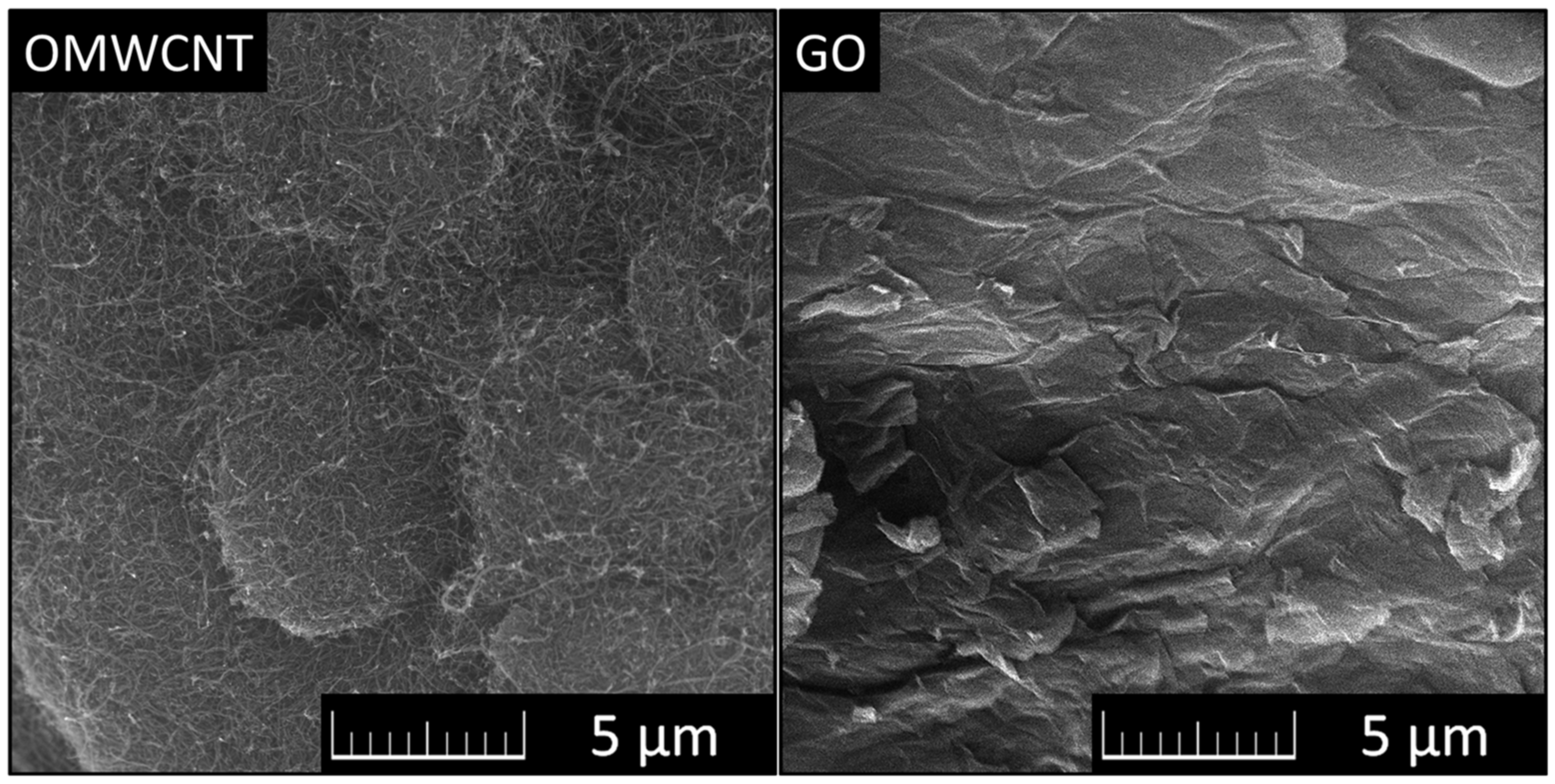
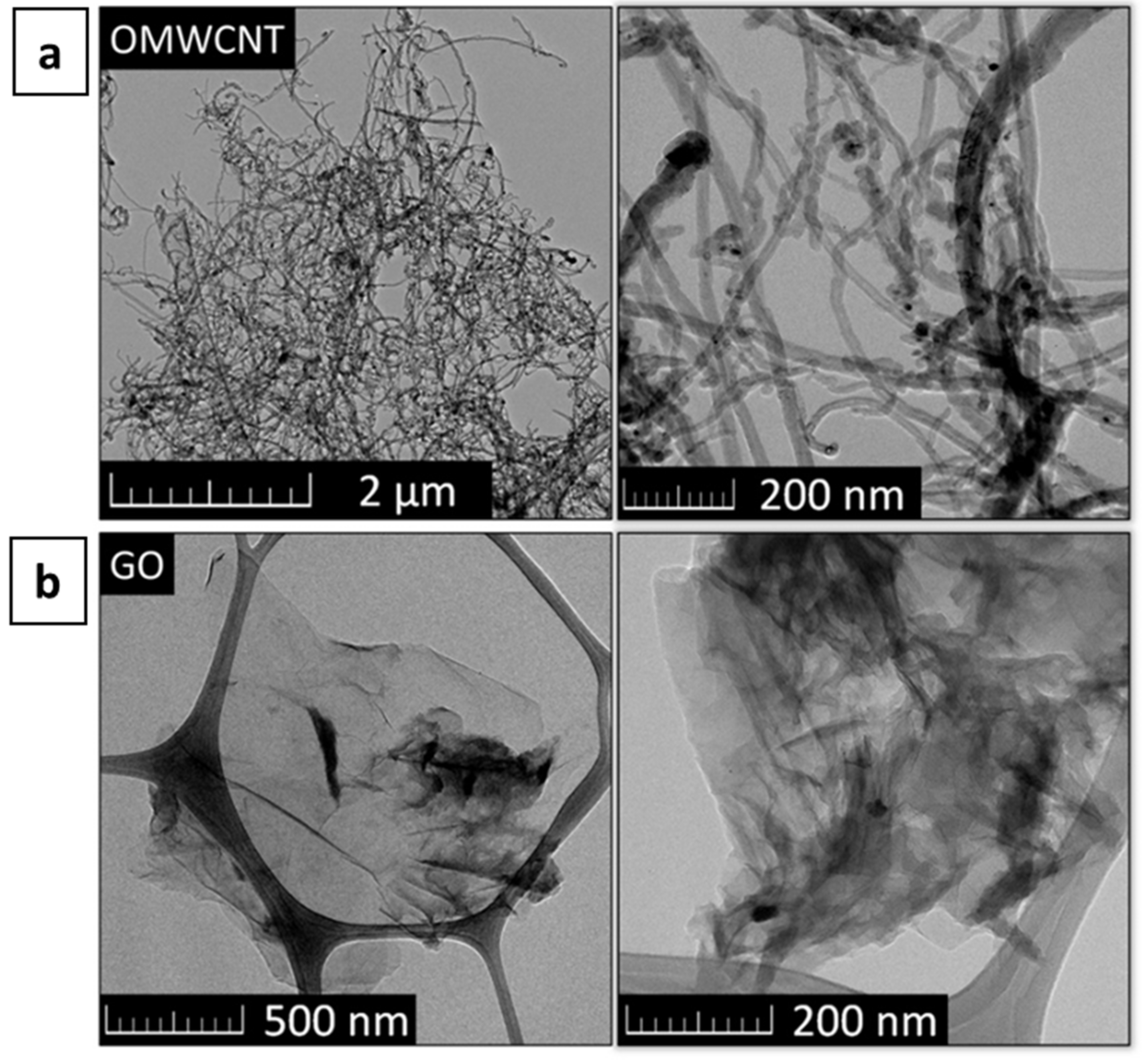
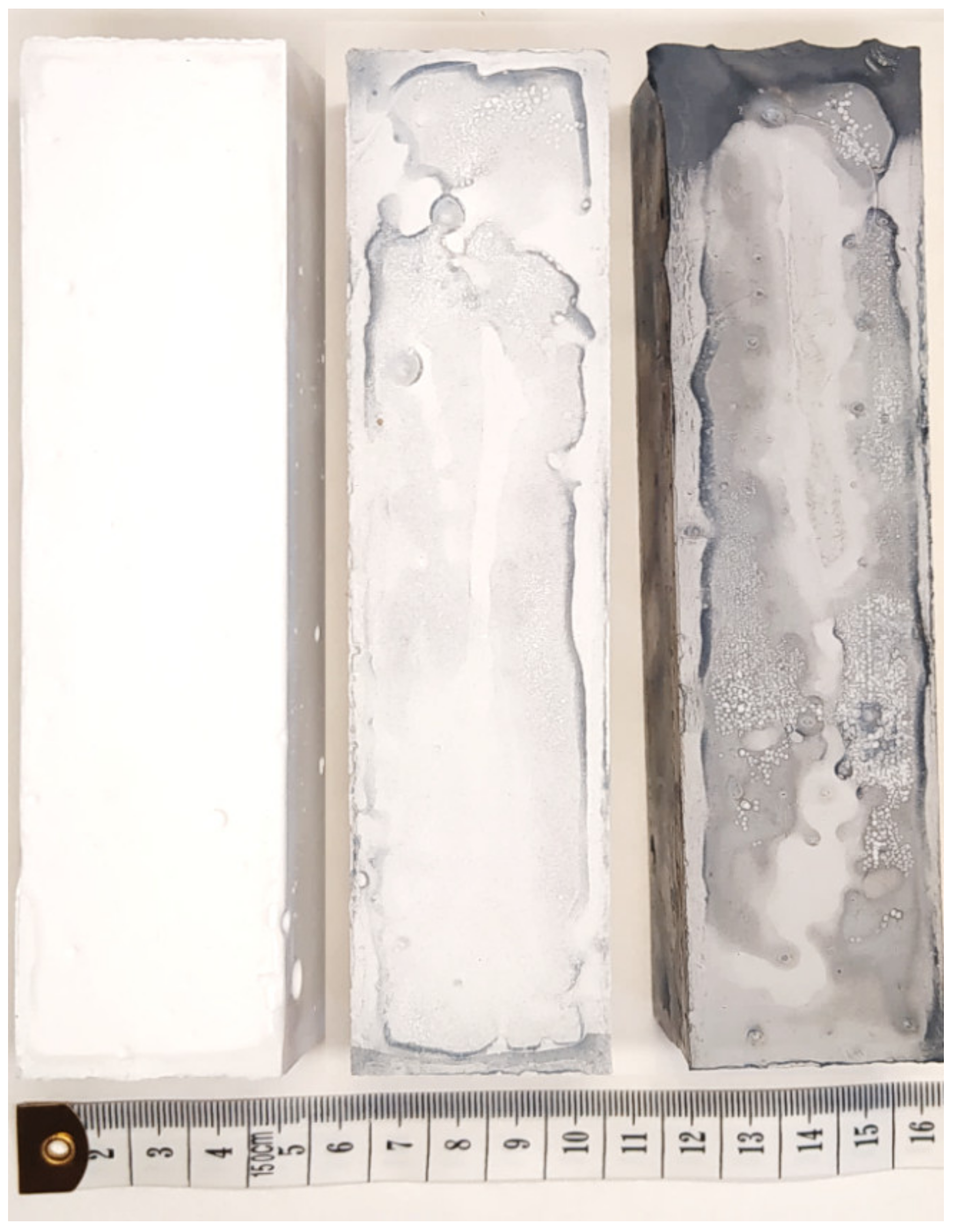

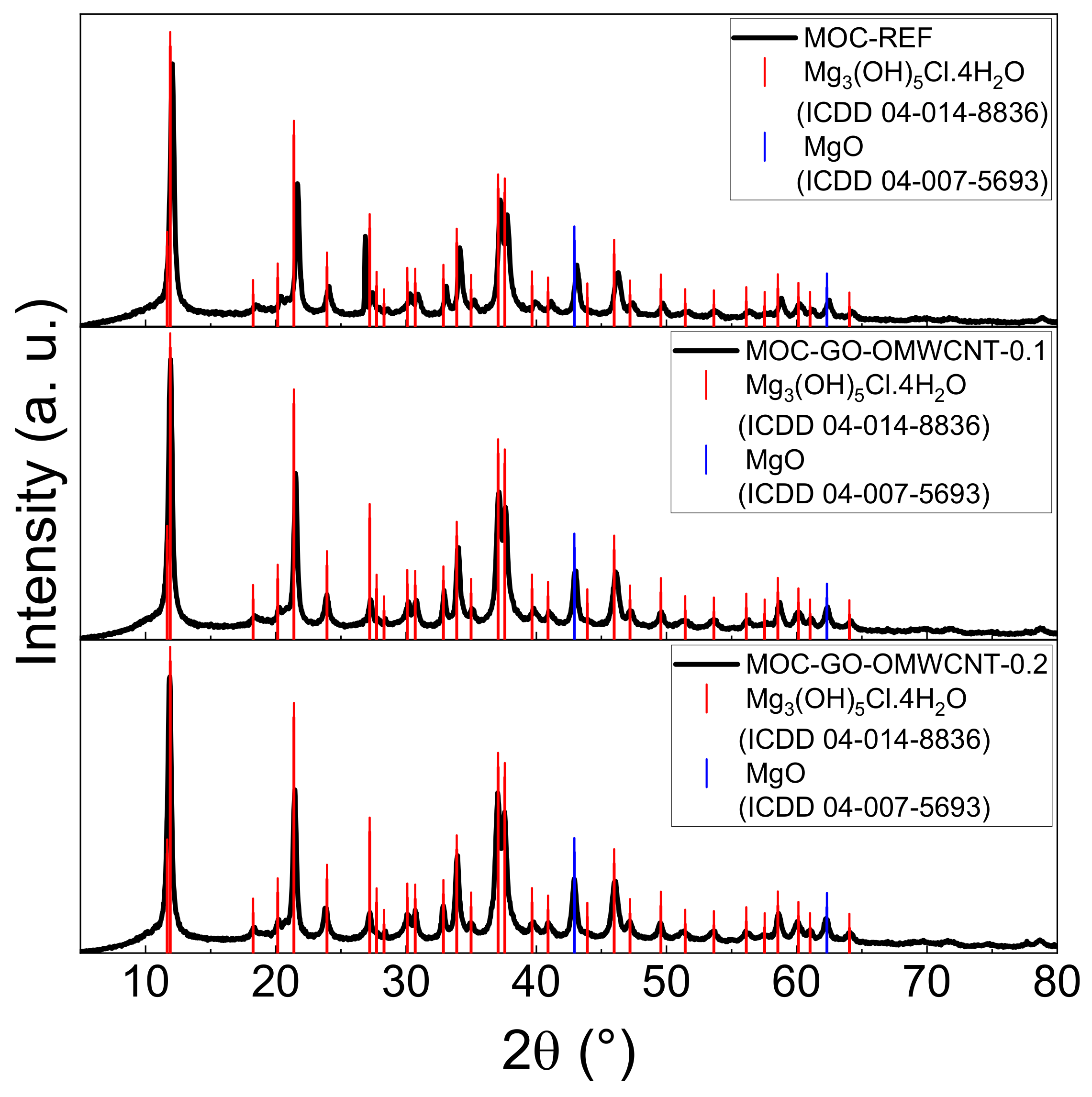
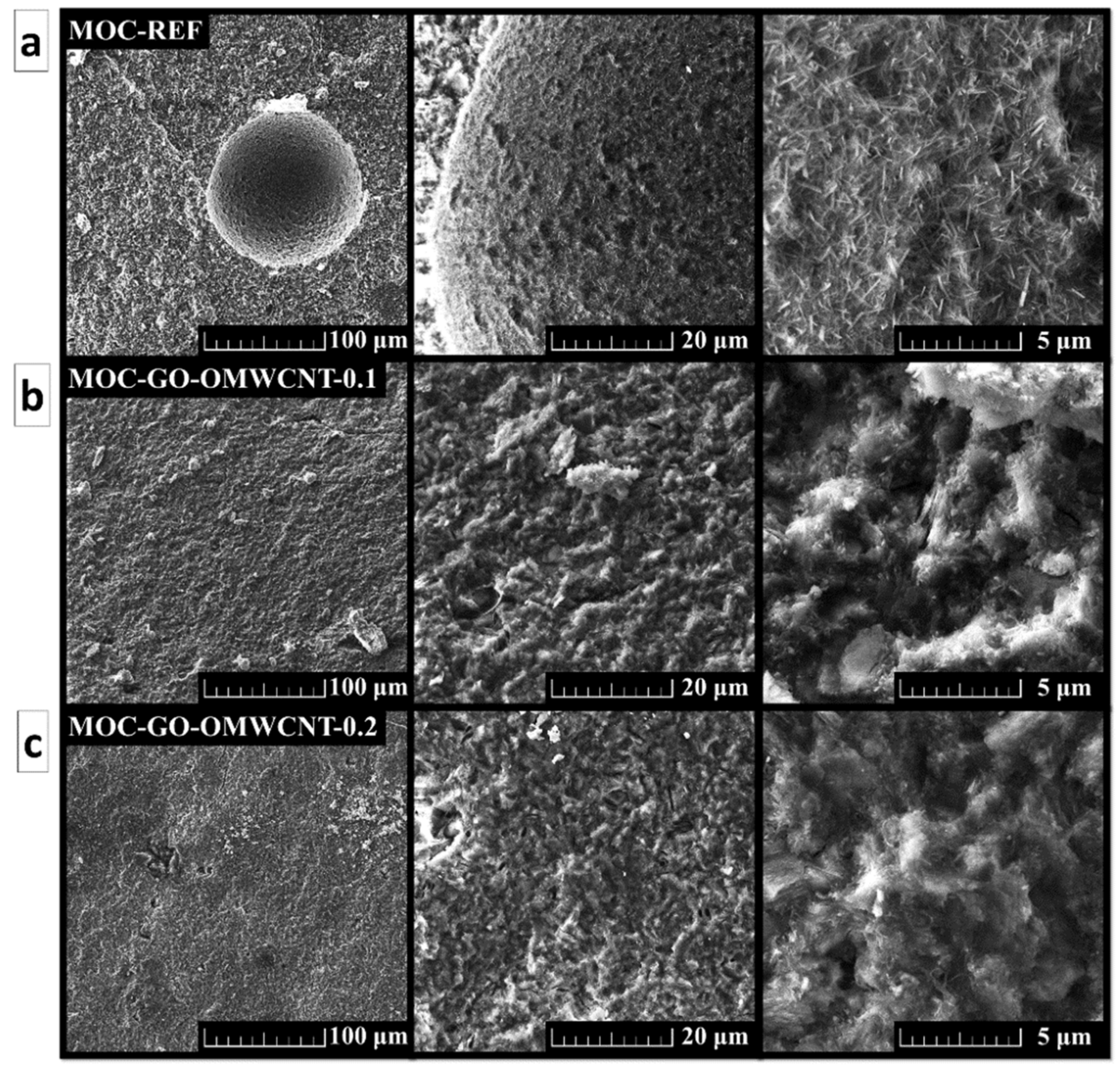
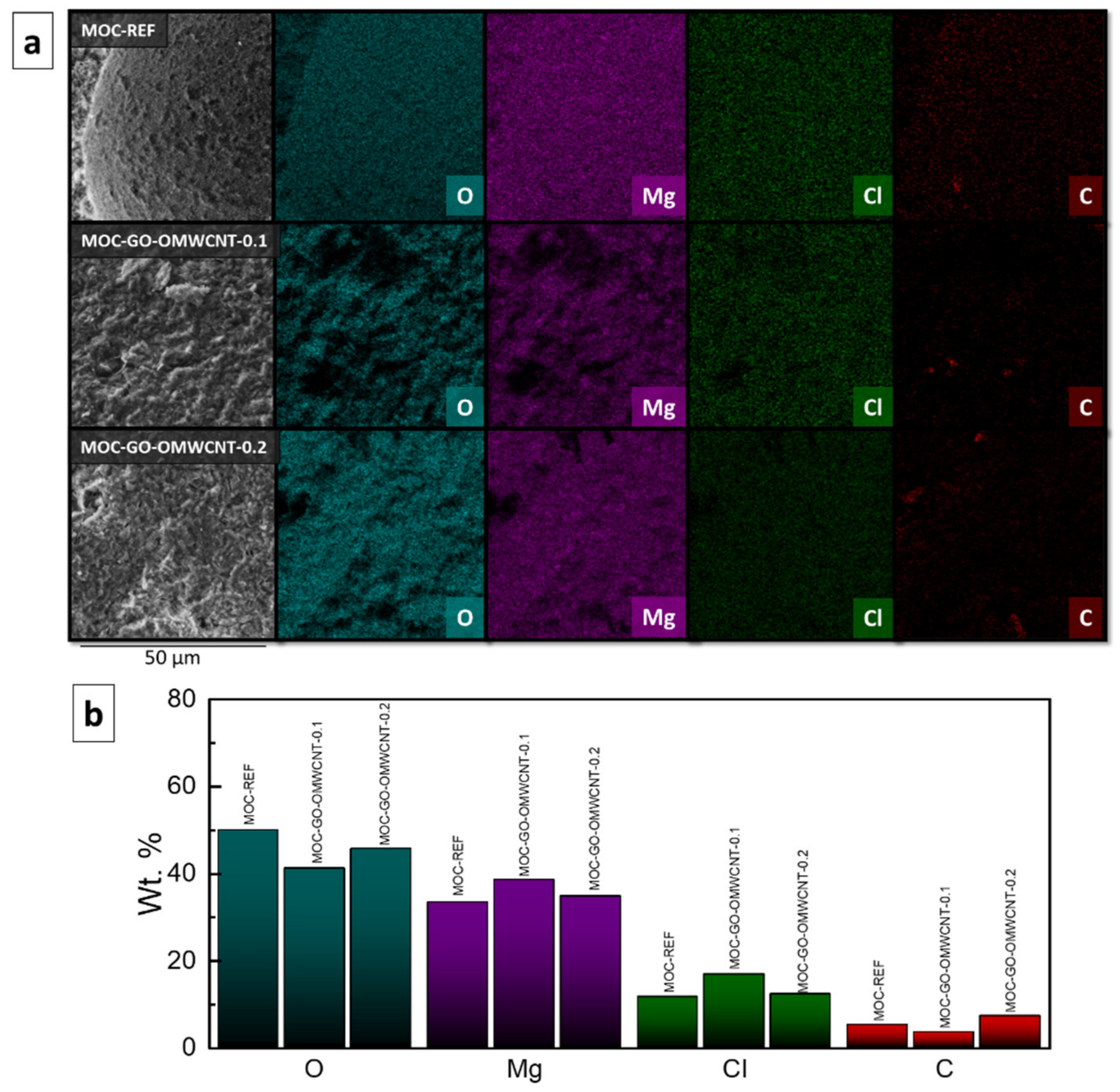

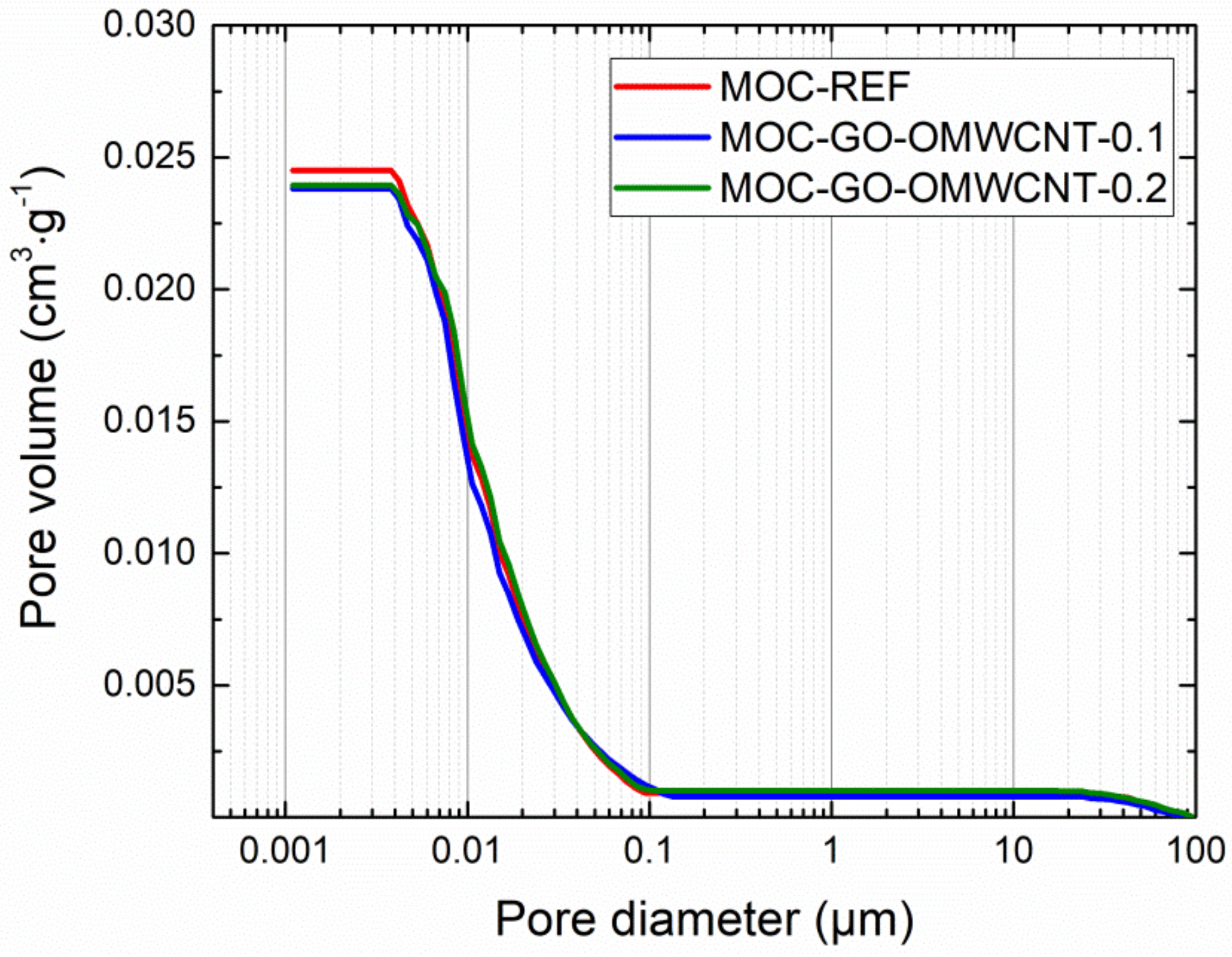


| EDS wt. % | C | O | S | Ni | Al |
|---|---|---|---|---|---|
| OMWCNT | 96.2 | 2.6 | - | 0.8 | 0.4 |
| GO | 65.7 | 32.6 | 1.7 | - | - |
| Mixture/Composite | Mass (g) | ||||
|---|---|---|---|---|---|
| MgO | MgCl2·6H2O | H2O | GO | OMWCNT | |
| MOC-REF | 553.6 | 399.0 | 247.3 | - | - |
| MOC-GO-OMWCNT-0.1 | 552.5 | 398.2 | 246.9 | 1.2 | 1.2 |
| MOC-GO-OMWCNT-0.2 | 551.4 | 397.4 | 246.4 | 2.4 | 2.4 |
| Material Parameter | Symbol | Unit | ECU (%) | Method/Standard |
|---|---|---|---|---|
| Bulk density | ρb | (kg·m−3) | 1.4 | EN 1015-10 |
| Specific density | ρs | (kg·m−3) | 1.2 | Helium pycnometry |
| Total open porosity | Ψ | (-) | 2.0 | Gravimetry/pycnometry |
| Flexural strength | ff | (MPa) | 1.4 | EN 1015-11 |
| Compressive strength | fc | (MPa) | 1.4 | EN 1015-11 |
| Dynamic modulus of elasticity | Ed | (GPa) | 2.3 | Ultrasonic pulse velocity |
| Water absorption coefficient | Aw | (kg·m−2 s−1/2) | 2.3 | EN 1015-18 |
| 24-h water absorption | W | (kg·m−2) | 1.2 | EN 1015-18 |
| 24-h water absorption | Wa | (wt. %) | 1.2 | EN 1015-18 |
| Thermal conductivity | λ | (W·m−1·K−1) | 2.3 | Hot disk |
| Thermal diffusivity | a | (m2·s−1) | 2.6 | Hot disk |
| Volumetric heat capacity | cv | (J·m−3·K−1) | 2.6 | Hot disk |
| Wavenumbers (cm−1) | Assignment |
|---|---|
| 3695 | stretching (ν) vibration of O-H in Mg(OH)2 |
| 3677 | stretching (ν) vibration of O-H in crystalline hydroxyl |
| 3647 | stretching (ν) vibration of O-H in silicate hydrates |
| 3611–3609, 3585 | stretching (ν) vibration of H-O-H in MgCl2·8H2O |
| 3388–3391 | stretching (ν) vibration of H-O-H in H2O |
| 1644, 1149 | bending (δ) vibration of H-O-H in MgCl2·8H2O |
| 1607 | stretching (ν) vibration of C=C |
| 1417, 1446 | stretching (ν) C=O in MgCO3 |
| 1455–1423 | stretching (ν) O-H in C-S-H and M-S-H phase, |
| 592–584 | deformation (δ) and stretching (ν) lattice vibrations of Mg-Cl/Mg-O |
| 517–524, 457 | translation vibrations of Mg/Mg-O, Mg-OH, and stretching (ν) vibration of O-Si-O in diatomite |
| 429 | bending (δ) vibration of O-Si-O in diatomite |
| 414 | vibrational modes of the lattice showing the Mg-O/Mg2+, O/O-Mg-O/O-Mg2+-O bonds |
| Composite | Bulk Density ρb (kg∙m−3) | Specific Density ρs (kg∙m−3) | Total Open Porosity Ψ (%) |
|---|---|---|---|
| MOC-REF | 1785 ± 25 | 1855 ± 22 | 3.8 ± 0.1 |
| MOC-GO-OMWCNT-0.1 | 1801 ± 25 | 1861 ± 22 | 3.2 ± 0.1 |
| MOC-GO-OMWCNT-0.2 | 1812 ± 25 | 1862 ± 23 | 2.7 ± 0.1 |
| Composite | Average Pore Diameter (µm) | Median Pore Diameter (µm) | Total Pore Surface Area (m2·g−1) | Total Pore Volume (cm3·g−1) |
|---|---|---|---|---|
| MOC-REF | 0.0113 | 0.0135 | 10.536 | 0.0298 |
| MOC-GO-OMWCNT-0.1 | 0.0105 | 0.0127 | 9.258 | 0.0240 |
| MOC-GO-OMWCNT-0.2 | 0.0103 | 0.0111 | 8.605 | 0.0238 |
| Composite | Water Absorption Coefficient Aw (kg∙m−2∙s−1/2) | 24-h Water Absorption W (kg∙m−2) | 24-h Water Absorption Wa (wt.%) |
|---|---|---|---|
| MOC-REF | 2.5 × 10−3 ± 6 × 10−5 | 1.071 ± 0.013 | 0.9801 ± 0.1 |
| MOC-GO-OMWCNT-0.1 | 1.9 × 10−3 ± 4 × 10−5 | 0.803 ± 0.009 | 0.6313 ± 0.1 |
| MOC-GO-OMWCNT-0.2 | 1.8 × 10−3 ± 4 × 10−5 | 0.651 ± 0.008 | 0.5742 ± 0.1 |
| Composite | Thermal Conductivity λ (W∙m−1∙K−1) | Thermal Diffusivity a × 10−6 (m2·s−1) | Volumetric Heat Capacity cV × 106 (J·m−3·K−1) |
|---|---|---|---|
| MOC-REF | 1.276 ± 0.029 | 0.493 ± 0.013 | 2.588 ± 0.067 |
| MOC-GO-OMWCNT-0.1 | 1.322 ± 0.030 | 0.494 ± 0.013 | 2.675 ± 0.070 |
| MOC-GO-OMWCNT-0.2 | 1.334 ± 0.031 | 0.474 ± 0.012 | 2.815 ± 0.073 |
Publisher’s Note: MDPI stays neutral with regard to jurisdictional claims in published maps and institutional affiliations. |
© 2022 by the authors. Licensee MDPI, Basel, Switzerland. This article is an open access article distributed under the terms and conditions of the Creative Commons Attribution (CC BY) license (https://creativecommons.org/licenses/by/4.0/).
Share and Cite
Lauermannová, A.-M.; Jankovský, O.; Lojka, M.; Faltysová, I.; Slámová, J.; Pavlíková, M.; Pivák, A.; Marušiak, Š.; Pavlík, Z.; Záleská, M. Co-Doped Magnesium Oxychloride Composites with Unique Flexural Strength for Construction Use. Materials 2022, 15, 604. https://doi.org/10.3390/ma15020604
Lauermannová A-M, Jankovský O, Lojka M, Faltysová I, Slámová J, Pavlíková M, Pivák A, Marušiak Š, Pavlík Z, Záleská M. Co-Doped Magnesium Oxychloride Composites with Unique Flexural Strength for Construction Use. Materials. 2022; 15(2):604. https://doi.org/10.3390/ma15020604
Chicago/Turabian StyleLauermannová, Anna-Marie, Ondřej Jankovský, Michal Lojka, Ivana Faltysová, Julie Slámová, Milena Pavlíková, Adam Pivák, Šimon Marušiak, Zbyšek Pavlík, and Martina Záleská. 2022. "Co-Doped Magnesium Oxychloride Composites with Unique Flexural Strength for Construction Use" Materials 15, no. 2: 604. https://doi.org/10.3390/ma15020604
APA StyleLauermannová, A.-M., Jankovský, O., Lojka, M., Faltysová, I., Slámová, J., Pavlíková, M., Pivák, A., Marušiak, Š., Pavlík, Z., & Záleská, M. (2022). Co-Doped Magnesium Oxychloride Composites with Unique Flexural Strength for Construction Use. Materials, 15(2), 604. https://doi.org/10.3390/ma15020604









